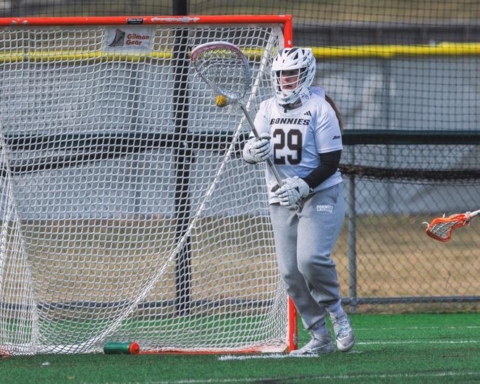photo courtesy of Conan Lynch
BY CONAN LYNCH, CONTRIBUTING WRITER
In the sport of lacrosse there are a few different positions. These positions are attack, defense, midfield, and goaltender. Attackmen typically stay on one side of the field and try to score goals. Defenders try to defend against the attackmen who are trying to score. Midfielders can run to both sides of the field and end up playing a mix of offense and defense. That brings us to the last position: goaltender. I’m a goalie, so I might be biased, but it is the hardest position in lacrosse.
The goalie is the last line of defense against the opponents. It is the job of the goalie to block shots from going into the goal. Now think about a hockey goalie. I am not saying that position is easy by any means, but shutouts, or completely stopping the opponent from scoring during a game, are not unheard of in hockey. The same cannot be said for lacrosse goalies. A hockey net is smaller than a lacrosse net, and hockey goalies have some serious protection with their pads. A lacrosse net is six feet across and six feet high and there isn’t much protection other than for the chest, head, hands and groin.
As a goalie, we have gloves with “extra thumb” protection. I say that cautiously because if you talk to any lacrosse goalie at any collegiate level there is a high chance that they have dealt with a thumb injury at some point in their playing career. We also wear helmets with a throat guard that hangs down below the chin. We have a chest protector which covers a majority of the torso. Lastly, we also wear a cup, often double layering it, to protect the groin area. Outside of this, there is no extra padding for the arms or legs. This also makes it a sometimes-painful position to play, considering shots are flying at the net upwards of 80 miles per hour.
ESPN’s Sport Science series did a study on the difficulties of playing goalie in lacrosse. On YouTube, a video called “ESPN2 Sport Science Features Tobii Pro Glasses 2 in a Lacrosse Study” breaks down how the study was conducted. According to the study, the fastest human reaction time to a visual stimulus is 200 milliseconds. A shot coming from 10 yards away and traveling at 105 miles per hour will reach the net in 190 milliseconds. This means some shots will be in the back of the goal before the goalie can react if they don’t anticipate where the shot is going. Being a goalie is the hardest skill-based position in lacrosse, and anyone who chooses to play the position must have a few screws loose if they enjoy facing impossibly fast shots being fired at them while wearing such little protection.
lynchcb19@bonaventure.edu









